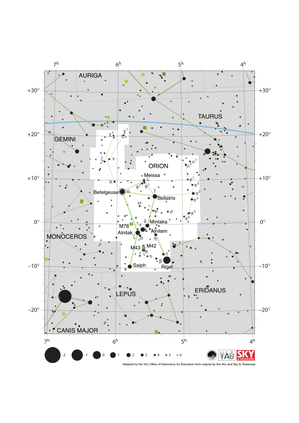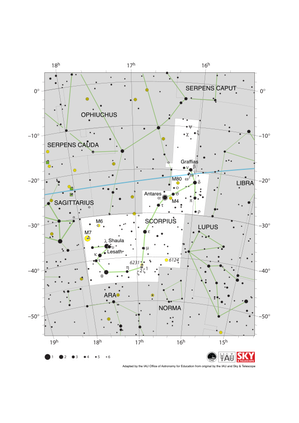Glossarbegriffe: Rektaszension (RA)
Description: Die Rektaszension ist eine der beiden Koordinaten im äquatorialen Koordinatensystem (die andere ist die Deklination), die Astronomen verwenden, um die Positionen von Himmelsobjekten am Himmel zu bestimmen. Von der Erde aus gesehen bilden die verschiedenen Positionen am Himmel zusammen eine weit entfernte Kugel mit der Erde im Zentrum: die Himmelskugel. Die Punkte am Himmel, die sich direkt über dem Äquator der Erde befinden, bilden auf dieser Himmelskugel den Himmelsäquator. Der Punkt direkt über dem geografischen Nordpol der Erde ist der himmlische Nordpol. Der Punkt über dem Südpol der Erde ist der himmlische Südpol. Genauso wie Geographen die geographische Länge und Breite auf der Erdoberfläche definieren, kann man die Länge und Breite auf der Himmelskugel definieren. Würden wir aber den Längengrad eines Himmelsobjekts als den des Ortes auf der Erde direkt darunter wählen, würde sich dieser Längengrad eines Sterns im Laufe der Zeit ändern, wenn sich die Erde dreht. Stattdessen messen die Äquatorialkoordinaten die Rektaszension als eine Form der himmlischen Länge relativ zu einem "Nullmeridian" am Himmel, der sich nicht mit der Erde dreht, sondern in Bezug auf die Fixsterne feststeht. Dieser himmlische Nullmeridian ist mit dem auf der Erde gebräuchlichen Nullmeridian von Greenwich vergleichbar. Er wird durch seinen Schnittpunkt mit dem Himmelsäquator definiert: genau an dem Punkt, an dem die scheinbare Bahn der Sonne den Himmelsäquator von der südlichen zur nördlichen Himmelshalbkugel kreuzt. Dieser himmlische Längengrad wird als Rektaszension bezeichnet. Ihr Wert nimmt nach Osten hin zu. Blickt man in Richtung des Himmelsäquators, dann ziehen die Längengrade im Laufe von (etwa) 24 Stunden an einem Beobachter vorbei. Aus diesem Grund wird die Rektaszension in der Regel im Zeitmaß angegeben, wobei 24 Stunden den vollen 360 Grad entsprechen. Die Deklination, die zweite Polarkoordinate, entspricht der geografischen Breite. Durch eine leichte Schwankung der Erdrotationsachse, die als Präzession bezeichnet wird, ändert sich das äquatoriale Koordinatensystem und damit auch die Rektaszension und Deklination von Sternen und anderen Himmelsobjekten im Laufe der Zeit, allerdings nur sehr geringfügig und sehr langsam.
Zugehörige Glossarbegriffe:
See this term in other languages
Term and definition status: The original definition of this term in English have been approved by a research astronomer and a teacher The translation of this term and its definition is still awaiting approval
The OAE Multilingual Glossary is a project of the IAU Office of Astronomy for Education (OAE) in collaboration with the IAU Office of Astronomy Outreach (OAO). The terms and definitions were chosen, written and reviewed by a collective effort from the OAE, the OAE Centers and Nodes, the OAE National Astronomy Education Coordinators (NAECs) and other volunteers. You can find a full list of credits here. All glossary terms and their definitions are released under a Creative Commons CC BY-4.0 license and should be credited to "IAU OAE".
If you notice a factual or translation error in this glossary term or definition then please get in touch.
Related Diagrams
Andromeda Constellation Map
Bildnachweis: Adapted by the IAU Office of Astronomy for Education from the original by IAU/Sky & Telescope
License: CC-BY-4.0 Creative Commons Namensnennung 4.0 International (CC BY 4.0) icons
Crux Constellation Map
Bildnachweis: Adapted by the IAU Office of Astronomy for Education from the original by IAU/Sky & Telescope.
License: CC-BY-4.0 Creative Commons Namensnennung 4.0 International (CC BY 4.0) icons
Orion Constellation Map
Bildnachweis: Adapted by the IAU Office of Astronomy for Education from the original by IAU/Sky & Telescope
License: CC-BY-4.0 Creative Commons Namensnennung 4.0 International (CC BY 4.0) icons
Libra Constellation Map
Bildnachweis: Adapted by the IAU Office of Astronomy for Education from the original by IAU/Sky & Telescope
License: CC-BY-4.0 Creative Commons Namensnennung 4.0 International (CC BY 4.0) icons
Scorpius Constellation Map
Bildnachweis: Adapted by the IAU Office of Astronomy for Education from the original by IAU/Sky & Telescope
License: CC-BY-4.0 Creative Commons Namensnennung 4.0 International (CC BY 4.0) icons













